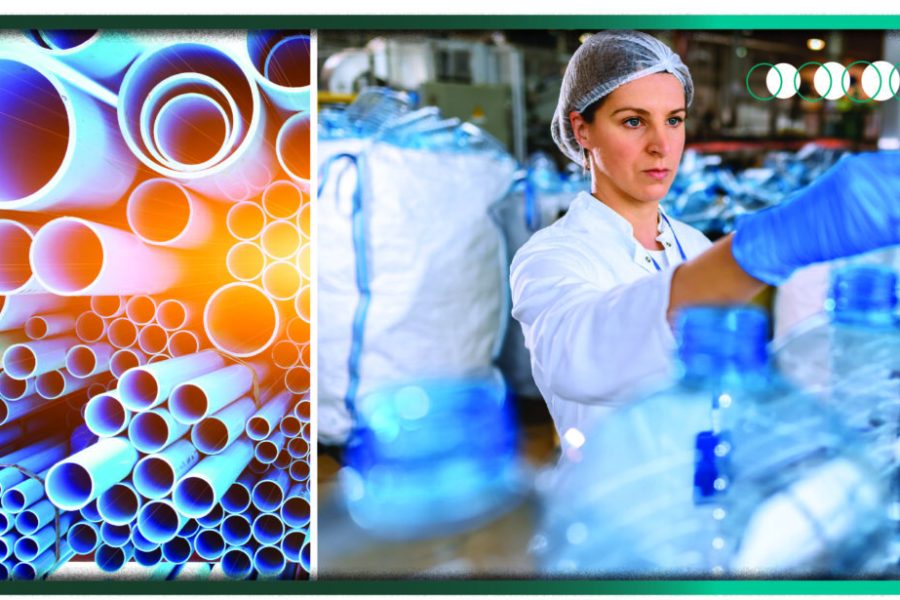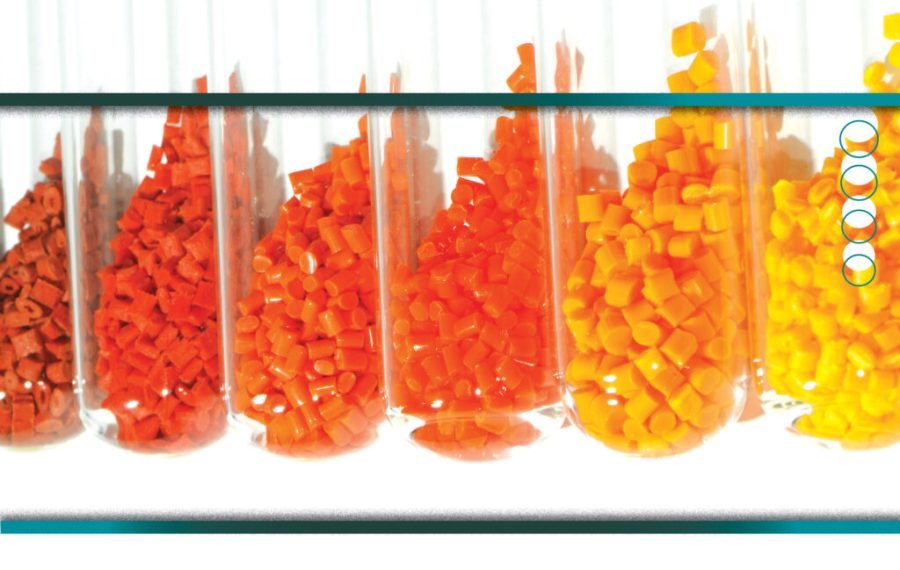

Plastics: Projections Rising with Demand for Biodegradable
Published Wednesday, January 25, 2023
By Mark R. Smith, Contributing Write

While the expression “It’s complicated” is generally used by people in various and sundry settings to describe some of life’s less-workable situations, it’s not such a tired cliché as it applies to the plastics industry.
What’s happening with myriad types of plastics really is complicated. It can also be overwhelming, upsetting and alarming, given how much of the product that we all use every day – which is not usually biodegradable – that gets thrown in the trash instead of the recycle bin. Or in the street or in green spaces and waterways.
But the world’s need for it is insatiable and only growing more so: Consider that the global plastics market is projected to grow from $457.73 billion in 2022 to $643.37 billion by 2029, at a compound annual growth rate of five percent in forecast period 2022-2029, according to Fortune Business Insights.
“With the demand for plastic forecast to continue rising, growth in production and consumption is coupled with an inefficient global waste management system, resulting in less than a fifth of plastic waste being recycled,” said Magnus Kolaas, senior vice president of Noone4u, a technology investment company in the circular economy located in Charleston, South Carolina, from his own estimates.
Location Updates
While “There is nobody who doesn’t agree that biodegradable is the future,” Kolaas said, “how to work to improve the world’s environment while being cost-effective is the major hurdle.”
“Scale and price is the challenge,” he said. “The concern in the industry is that there’s no replacement for the oil-based polymers on a large scale. There are a number of different solutions, but so far no solution can handle the scale or the price levels.”
While the industry wrestles with that dilemma, it also has to address location issues. When advising plastics companies, site selectors break their strategies into two segments. Dennis Donovan, principal with the Bridgewater, N.J.-based WDG Group stated, “Makes of polymers/resin that is used by injection molders; and those that manufacture component parts.”
The reason? The polymers/resin group “includes custom compounders that are very reliant on energy,” said Donovan. “Those companies don’t have to be too fine about where they locate, since their needs for energy are immense” and tend to dictate those decisions.
For that upstream segment, Texas is the predominant state; next in line are Michigan, Ohio and Illinois, due to production of natural gas/fracking and end users of the polymers being located in those states. For products, the predominant region is Midwest, followed by Texas, the southeast and New England. Almost all of those localities are focusing on efficient production processes and moving into states that have progressive sustainability policies, like New York, Virginia, North Carolina, and Missouri.

Donovan said he’s seeing “a considerable amount of location updating” due to client desire for more accessible locations due to COVID-19, offshoring from China and general expansion of the industry. “I don’t know that I’d call the expansion robust, but there is a significant level of activity, which is often the case in the plastics industry since the demand is so great.”
A mere glance at one’s daily habits offers ample reason for the vast need. “They’re part of almost all industrial and consumer applications,” said Donovan, “as they have become stronger and more lightweight over the years.”
How great is the demand? He cited global revenues for the total sector in 2021 were $593 billion and have been growing roughly four to five percent in recent years, according to Research & Markets, as well as Grand View Research; domestically, 14 percent of that amount, or $86 billion, comes from the U.S., also according to Grand View.
As for the employed base, the industry’s workforce approximates 696,000 in the U.S. This includes polymers/resins and plastic products manufacturing, according to data from Jobs EQ.
Now Hiring
When it comes time for a company to expand, Donovan considers several factors. “I want to know where its customer base is concentrated, where materials come from and the scale of the operation,” he said, “especially as it relates to workforce needs, given the lack of available talent.”
That scarcity of workers makes it “imperative” for firms to integrate into a labor market “with available talent, as well as good technical education/training programs at two to four year colleges,” Donovan said, noting that more and more companies are starting to address the issue through the use of robotics and even 3D printing, which still require higher-skill labor, but fewer employees to run a plant.
Other key location factors include available buildings that can be built out easily “since time-to-market is important in this industry,” he said, as well as easy access to affordable electric power, and solid transportation for workforce and shipping needs. While local taxation and incentives are often much ballyhooed when it comes to attracting businesses, they’re really just icing on the cake in the plastics industry.
“The other factors come first,” he said, adding that “companies should never be led by tax incentives.”
While those key points are all in play, the industry’s impressive and growing numbers are speaking louder than ever of the almost surreal need for recyclability and reuse.
“There is a major push for recycling and to make the polymers biodegradable that is being led by businesses such as the Anderson, Ind.-based Sirmax Group, which recycles polypropylene,” said Donovan. “It takes a major effort to set up recycling and the industry is nowhere near where it wants to be, but more companies are becoming proactive.”

On the Shelf
Proactive describes the efforts of Accredo Packaging, of Sugar Land, Texas, a manufacturer of traditional, recyclable and compostable flexible plastic packaging that is often used for food products. The amount of product it produces tends to be consistent for two basic reasons.
“Even with today’s bad economy, people are still eating and shopping at home, so the demand is just as strong as it was during the height of the pandemic,” said Mandy Craig, Accredo’s global head of marketing and sustainability. “I think the habits that people developed regarding eating and working at home during the worst of COVID-19 will remain, at least for the indefinite future.”
Craig said that Accredo is reducing its carbon footprint by preserving food for longer periods with its packaging. “We’re in front of the industry in terms of a high-barrier performance product that is still recyclable” which is made from polyethylene packaging – nos. 2 and 4, in fact, out of the seven basic types of plastic.
And what’s the kicker? “More than 80 percent of what we make today is recyclable,” she said, “and is less expensive to make than compostable products.”
That bodes well when addressing the demands of Accredo’s huge clients like Kroger, Target and Walmart “that all want fully recyclable packaging on their shelves,” she said, “store shelves today are displaying a great deal of non-recycled packaging. Therefore, a substantial percentage of retail packaging still needs to make the transition to recyclable.”
Some of the company’s clients already want to take an even bolder step: something even more advanced than basic recyclable packaging. “For instance, they’re looking for packaging that is made from recycled content, such as what comes from the curbside bin and/or plant-based materials,” said Craig, like sugar cane, wheat or even compost.
She said that while Accredo “thought that the pandemic would slow down innovation, we’ve found just the opposite. Innovation is moving forward. When you eat at a restaurant, there is just as much or even more packaging waste, but the consumer doesn’t see it; today, more people are eating at home and thinking more about the environment. That has been driving the movement, especially because millennials are demanding recyclable packaging.”
While the various sectors of different industries have often struggled to get on the same page with their efforts, Craig cited the 2025 sustainability goals of the Ellen MacArthur Foundation, which have been accepted by many larger corporations and retailers.
“In many cases, it requires 100 percent of packaging to be recyclable, reusable and/or compostable by 2025,” she said.
Innovation Reigns
Given Craig’s observations, what Patrick Krieger, vice president of sustainability for the Washington-based Plastics Industry of America, sees as the main trend not only isn’t a surprise, it’s rather encouraging.
“What you will find,” said Krieger, “is that in recent years, [the main trend has] been innovation in sustainability. That’s important and encompasses manufacturing more easily recyclable products.”
But the expanse of available products is part of the issue. For instance, a December 2022 McKinsey report identified 14 areas where plastics are commonly used and offered alternatives. “In 12 of those instances,” Krieger said, “plastics were proven to be the best use.”
However, “There are hundreds of types of plastic and that can make certain types of products hard to recycle,” he said. “They fall within different categories which reflect how they are used, such as commodity, specialty and engineering products.”
That shows the importance of using recyclable materials whenever possible, especially given the amount of product that’s manufactured, potential reuse and climate change, increasing pressure from society and a world that’s become increasingly jittery about the potential for bad outcomes.
So industry is changing, in this case in a good way. “Making products easily recyclable used to be a nice bonus,” said Krieger. “Now, it’s more of a necessity because brands want to be doing the right thing.”
That concept has been embraced by much of Corporate America. “If you’re looking at large corporations like Dow Chemical, know that it, for instance, wants to make recycling more accessible to the general public,” said Nima Farshchi, director of the Center for Social Value Creation for the Robert H. Smith School of Business at the University of Maryland College Park. “For instance, Dow and Waste Management are working to promote greater acceptability of recycling.”

He said it goes hand-in-hand with Krieger’s point about Corporate America focusing on reducing plastic production, which impacts the Environmental, Social and Governance scores that big banks consider when making investments. “That’s the biggest trend domestically,” he said, “as more banks are analyzing these scores in their ‘investability’ factor.”
As far as changing perceptions about the need to recycle, “Many ESG funds have already been successful, though several southern states, such as Texas, Kentucky, Louisiana and others, are in the process of rejecting it,” said Farshchi. He noted, however, that ESG funds “performed well during the pandemic.”
While Krieger “won’t be bashful about plastics being great materials,” at the same time he recognizes just what Corporate America does, “that there are some opportunities to improve their sustainability that need to be addressed.”
As it turns out, Krieger said the domestic industry should emulate what’s going on across the pond. “The European Plastic Waste Directive has new rules that call for packaging to be less wasteful,” he said. “For instance, they will have recycling rate targets and minimum recycled content for many different types of packaging and plastics. In addition, the new proposal also puts in requirements for reuse or refill.”
Farshchi added to that observation and also suggested following the lead of the European Union, which is setting requirements for plastic waste in an effort to reduce the amount by around 20 percent by 2030; and total greenhouse gas emissions by 55 percent by 2030 from where they stood in 1990.
Apparently, those efforts in the EU have been noticed in Washington. “Also, the Biden administration is pushing for a House Resolution for the Environmental Protection Agency to increase regulations on plastic since the 2022 United Nations Climate Change Conference a few weeks ago,” he said, noting the next conference is set for Nov. 30, 2023, when world leaders will again discuss shared metrics to reach goals.
The point is that plastic needs to be reduced “and countries are taking note, either by producing less or better waste reduction,” and Farshchi said, that the EU is demanding that all plastic packaging is be recyclable by 2030.
An Answer?
While there are numerous admirers of the European approach, finding the right compounds to make recyclable products domestically remains front-and-center. Kolaas said he’s “paying attention to a certain ingredient” that the casual observer might not suggest “as a strong contender to take center stage the race to become biodegradable: algae.”
“To solve the challenge of scale, new competence and capital needs to access the production, industrializing the production, so it can reach the required volumes to be seen as an important raw material supplier,” he said.
The correct answer has yet to arise, but the plastics manufacturers have to move on developing new types of biodegradable plastics. “Besides the recycled plastic,” Kolaas said there are small-scale pilots being conducted with plastic produced from agricultural residues, algae and biomass.
“We have seen H&M and North Face making fashion out of algae, but unfortunately both of them have stopped,” he said, though adding that “Adidas and other shoe brands are using algae” in the manufacturing of their shoes.
Kolaas also discussed Polylactide (also known as PLA, which is a thermoplastic polyester that serves as the raw material in 3D printing or additive manufacturing processes that is extracted from natural sources like sugarcane or corn), calling it “one of the most efficient materials” since it uses less feedstock to generate biodegradable plastics.
“The world produces approximately 300,000 tons of PLA annually. Since only nine percent of all plastics globally are recycled, there is a promising algae market, if we succeed in industrializing the production of algae-based PLA,” he said.
Just how bullish is Kolaas on algae? He even called it a “most likely a star of the future.”
There’s an important reason for that stance: accessibility. “It can grow where we can’t grow other crops,” he said, “and also because it grows faster than any terrestrial plant, absorbing more CO2 than any other plant on the planet.”
